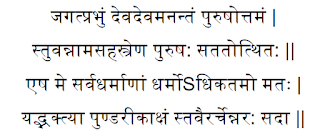Businesses spend large of amount of time and money to develop Business Continuity and Resiliency Plan that describes actions to be taken to quickly recover from disaster. The idea is to have minimum or no impact on business operations in case of disaster - be it a natural calamity or market crisis.
Life is also like business. Anything can happen in life. Those who have thought about and have prepared for the worst are the ones who survive through the disaster with minimum or no impact on day to day life. There is a saying that "when going gets tough, the tough get going". This toughness is a result of deep thinking about life from all angles.
Whereas paying too much attention to threats of life can destroy joy of life, paying no attention can pose the great risk of getting heavily impacted by disaster. There is a saying in marathi "पश्चात्तापापेक्षा ताप बरा" meaning it is much better to have stress of thinking before action than the stress from the undesirabe result of an action.
However, there is an easy way to get secured from all threats and yet enjoy the life to its fullest. And that is – follow dharma.
Pandavas and their consort Draupadi are classic examples of dharmic (religious) persons who faced unforeseen dire calamities throughout their life and yet in every calamity they were protected by creator of dharma i.e. Lord Shrikrishna. Lord Shrikrishna always stood behind Pandavas. Relation between Lord Shrikrishna and Panadavas demonstrates how protection of dharma protects the protector of dharma. Pandavas never ignored their Guru’s i.e. Lord Shrikrishna’s warnings and promptings. For them Lord Shrikrishna’s word was final word. Whereas Duryodhana and his brothers ignored warnings of Lord Shrikrishna and so they met a painful end.
Pandavas received immense knowledge from their elders and Lord Shrikrishna himself. All that knowledge is available to all human beings through the story of Mahabharata.
After kurukshetra war, Pitamah Bhishma, lying on a bed of arrows, explained to Yudhishthira, eldest of Pandavas, all dharmas that a king is supposed to follow. Though Yudhisthira received very valuable knowledge from Pitamah about running kingdom, he still had some doubts in his mind about dharma that is common to all human beings. He asked six questions to Pitamah Bhishma in relation to this, one of them was
O Pitamah, in your opinion, which is the best dharma (righteous deed) among all dharmas (righteous deeds)?
Pitamah Bhishma, exhilarated by Yudhishthira’s questions, answered
In my opinion, the best among all dharmas is to worship lotus eyed Lord Vishnu by incessantly chanting his thousand holy names.
After answering such, Pitamah Bhishma narrated all thousand names of Lord Vishnu to Yudhishthira and they were then compiled by Sage Vyasa as Srimad Vishnusahasranama.
One who incessantly chants or listens to thousand holy names of Lord Vishnu gets easily protected from all calamities.
Not only that, by chanting these holy names, or by just chanting Rama nama, which is equivalent to chanting thousand names, all dharmas of an individual get automatically followed.




No comments:
Post a Comment